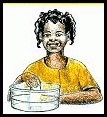Indoor Air Pollution
When we talk about air pollution, we often think of smog, chemicals produced by factories or exhaust from cars. These are problems that usually affect the air outdoors. But most of us spend much of our lives inside buildings. We go to school or work indoors. We eat our meals, do our homework, play and sleep indoors. All of that time, we breathe air that is in the room.
Indoor air can become polluted, or spoiled, by adding harmful things to it, just as outside air can. For example, household cleaners, dust, paints, bug sprays, smoke from cooking or cigarettes, and fibers from some building materials all can make indoor air unhealthy to breathe. We often need to keep doors and windows closed to keep the insides of our buildings cool in the summer or warm in the winter. This can trap pollutants inside for a long time. It also can make places for insects, dust mites and molds to live.
Some pollutants of indoor air are so irritating that they can bother anyone who breathes them. Indoor pollution can come from:
- Paint
- Tobacco smoke
- Furniture and carpeting (for example, chemicals that make them difficult to burn)
- Building materials
- Scented candles (burning candles releases pollutants)
- Cleaning products
- Mold
- Pet dander (skin flakes from an animal’s hair or fur)
Other polluters can cause more problems for some people than for others. For example, some people are allergic to things in dust. When they breathe dusty air, people with allergies may start to sneeze or have runny noses and itchy eyes. Once in a while, more serious breathing problems, such as asthma, are caused by dust.
How can we keep the air inside our homes and other buildings clean and safe? A little common sense goes a long way. We can be careful about using chemical cleaners, paints, glues and pesticides, and, instead, use products that don't pollute. We can reduce the amount of dust in the air by changing the filters in our home heating and cooling systems.
We can get rid of some sources of indoor air pollution completely. For example, smoking is no longer allowed in many public buildings, such as movie theaters, hospitals and schools.
Most importantly, we can remember how important it is to have clean air to breathe inside our homes, schools and offices. Each of us can do something to help keep our indoor air clean.
Time to Experiment!
Can we "see" air? Try this in the sink, bathtub, or a large bowl of water. Turn a clear plastic cup upside down and push it down into the water. What happens? Is there any water inside the cup? Now, turn the cup slightly on its side. You will see a big bubble rush toward the surface of the water. What do you think the bubble is made of?
Some content courtesy of the National Library of Medicine.




